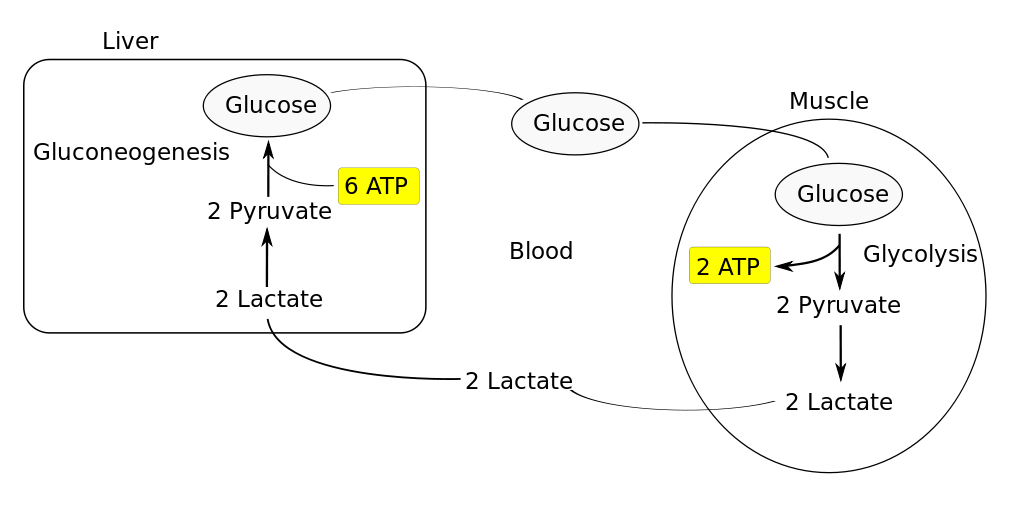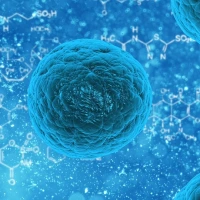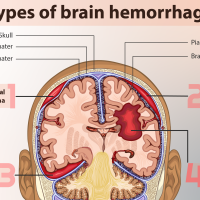What is the Cori cycle? What is the clinical significance of the Cori cycle?
The Cori cycle prevents lactic acidosis or the accumulation of lactate in the muscles. The Cori cycle also helps regenerate glucose needed during extreme muscle exercise. However, the Cori cycle cannot last forever. There are limitations to the Cori cycle, as it uses up 4 net ATP in total. Eventually, the body would undergo lactic acidosis, or need glucose from food to replenish energy and regain metabolic efficiency.

How does the Cori cycle work?
The Cori cycle also known as the Lactic Acid Cycle combines two important metabolic processes: 1) glycolysis and 2) gluconeogenesis. During extreme muscle exercise or activity, our muscles run out of oxygen and thus undergo anaerobic glycolysis. Anaerobic glycolysis uses 1 glucose to make 2 net ATP and 2 pyruvate. To regenerate NAD+ carriers, these 2 pyruvates from the anaerobic glycolysis also become reduced by lactate dehydrogenase into 2 lactates or 2 lactic acid during anaerobic fermentation.
Anaerobic glycolysis uses 1 glucose to make–> 2 net ATP + 2 pyruvate
Lactate dehydrogenase converts 2 pyruvate into –> 2 lactate

Lactic acid starts to accumulate inside our muscle cells, so our bodies undergo further of the Cori cycle to remove lactate and also convert lactate back to glucose in the Gluconeogenesis side for more energy.
The bloodstream carries lactic acid to the liver, which uses the 2 lactates for gluconeogenesis. Gluconeogenesis is the process of making new glucose, hence gluco=glucose , neo=new, and genesis=make/create. Thus, gluconeogenesis converts the 2 lactates into 2 pyruvates and back into 1 glucose. That glucose is then sent back to the muscles through the bloodstream for further glycolysis.
Gluconeogenesis uses up 6 ATP, unlike the anaerobic glycolysis that creates 2 net ATP.

How many ATPs does the Cori cycle use in total?
In total, the Cori Cycle uses up 4 net ATP:
6 ATP (used up by gluconeogenesis) – 2 ATP (created by glycolysis) = 4 ATP used up.
Where is the Cori Cycle located?
The Cori Cycle is located in both the Liver and the Muscle:
Anaerobic glycolysis occurs in the Muscle.
Gluconeogenesis occurs in the Liver.
What travels in the blood during the Cori cycle?
Glucose and lactate travel in the blood during the Cori cycle.
Glucose travels from the liver to the muscle.
Lactate travels from the muscle to the liver.
Works Cited
- Elmhurst College. Cori Cycle. http://chemistry.elmhurst.edu/vchembook/615coricycle.html
- Waterhouse, Christine. Cori cycle activity in man. NCBI https://www.ncbi.nlm.nih.gov/pmc/articles/PMC297493/
- Katz, Joseph, et al. Gluconeogenesis and the Cori cycle. American Journal of Physiology. https://www.physiology.org/doi/full/10.1152/ajpendo.1998.275.3.E537















Informative read. I enjoy the helpful diagrams and summaries. You make things easy!
LikeLiked by 1 person
Thank you Zachary! Glad to help with the diagrams and summaries!
LikeLike
Another excellent post! Learned something new today about the Cori Cycle
LikeLiked by 1 person
Thank you again Bob! Makes us happy to hear that. Happy learning!
LikeLike
Helpful thanks! Now I can think about this when I exercise.
LikeLiked by 2 people
Indeed! 😀 Cori cycle for the win during exercise. Thank you for learning with us, Mike.
LikeLike
Thank you helpful!
LikeLiked by 1 person
Thank you for your comment! We’re glad this helped!
LikeLike
Thank you♥️♥️
LikeLiked by 2 people
You’re welcome ❤
LikeLiked by 2 people